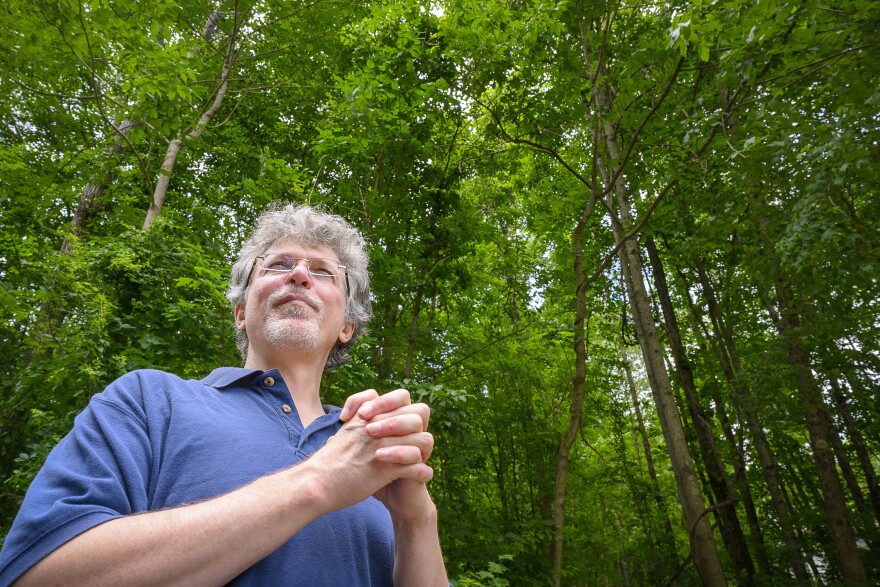A group of Connecticut cicadas disappeared nearly 70 years ago. Scientists still search for answers.

From atop Horsebarn Hill, University of Connecticut biologist John Cooley gestures toward a nearby area of the Ashford/Willington border where Brood XI — a group of periodical cicada— was last seen in Connecticut in 1954. “The irony is that the forests and climate here are more appropriate for the cicadas than they have been in hundreds of years,” says Cooley. “We think they are extinct…. But we go back, because proving that something is actually absent is a near-impossible task.” (Mark Mirko / Connecticut Public)
On a hill overlooking the Fenton River Valley, John Cooley gestures to a horizon blanketed with trees. It’s the bucolic embodiment of New England’s forested landscape.
It’s also the scene of a mystery that’s puzzled scientists for nearly 70 years.
What happened to a group of periodical cicadas that used to live here?
“You would think this is perfect periodical cicada habitat, there’s no shortage of forest,” said John Cooley, a member of University of Connecticut’s Hartford teaching faculty, who travels the country tracking and studying periodical cicadas.
This year should mark the emergence of Brood XI, which was plunked in the northern reaches of habitable cicada territory. But scientists haven’t seen that group since 1954, when two went into the valley Cooley is overlooking to search for cicadas.
“They came out here one day and collected a bunch of cicadas and probably didn’t think too much about it,” Cooley said. “In retrospect, that’s turned out to be really important.”
“That’s the last time it’s been seen,” Cooley said.
Today, scientists believe, but aren’t totally sure, that the brood is extinct. And there’s only one way to test that: head into the valley and search.
That’s why we are here. To go look for some cicadas.

Cicada habitat surrounds UConn biologist John Cooley as he takes a summer stroll along the Willington/Ashford border looking for cicada Brood XI — a group of periodical cicada last seen in Connecticut in 1954. (Mark Mirko / Connecticut Public)
Hunting for cicadas
Periodical cicadas emerge from underground every 13 to 17 years, depending on the group, to mate, lay eggs, and die. Connecticut’s last big emergence was in 2013.
When you’re in a cicada emergence, it’s like nothing else on Earth. Millions of insects erupt above ground for a few short weeks.
It’s magical. It’s also extremely noisy.
Here’s sound from an emergence Cooley recorded in upstate New York in 2018.
But in the Fenton River Valley, there are trees now grown stories high that were barely saplings the last time the hills carried the chorus of these charismatic red-eyed insects.
Cicadas are important indicators of forest health who spend years underground feeding on tree roots and cycling nutrients through a forest. Cooley said they’re one connection in a complex ecological web we don’t fully understand.
“Start breaking those connections – you don’t actually know what’s gonna happen,” Cooley said.
As for why Brood XI disappeared, there are ideas.
Cooley said the group was situated on the northern edge of habitable territory for cicadas — and living on the edge can give less wiggle room for survival.
“They’re limited by the conditions: either the harshness of the winter or … the shortness of the growing season,” Cooley said.
But no one is really sure why the cicadas vanished. Or if they’re even really gone.

A conventional light switch is a near perfect imitation of a cicada call in the hand of UConn biologist John Cooley as he tries to draw out cicada Brood XI. (Mark Mirko / Connecticut Public)
Listening for cicadas
Walking through a small neighborhood near the Ashford-Willington border, Cooley kept his eyes (well, mostly his ears) open for any hint of cicada activity.
Light broke through the tree canopy and he suddenly stopped to listen.
“Oh, look, here comes the sun. Now we listen,” Cooley said, pausing and looking toward the trees. “What do we hear? I don’t hear any cicadas.”
This is unglamorous science. Slogging down a street in the warm weather to look for an insect that’s almost certainly disappeared.
Cooley said when he came to this spot in 2005 – the last scheduled emergence of Brood XI – he actually flyered mailboxes here, begging people to report cicada sightings with a $100 reward.
“People thought I was crazy,” he said. “I thought, I’m not going to be paying out. And nobody took us up on it.”
Cooley took me to a forest edge bumping up against the street that would be a prime spot for males to call. If there aren’t a lot of cicadas, they can be hard to see and hear. But they can be enticed, if you know their mating sounds.
Cooley imitates the whistling call of a male and a female’s clicking response. He’s hoping to draw out a Brood XI survivor.
We walked around the neighborhood for about 90 minutes: calling, looking, listening, but finding nothing.

A specific frequency of whistle delivered by UConn scientist John Cooley is used as a cicada call while he takes a summer stroll along the Willington/Ashford border looking for cicada Brood XI. (Mark Mirko / Connecticut Public)
Cooley said it’s that search, even if it’s for something that is in all likelihood is gone, that cuts to the core of scientific inquiry.
Yes, Brood XI is extinct, scientists believe. But how can biologists be sure, if they don’t come out every 17 years to look, question, and verify?
“I have to test those statements that were made, and established, they still seem to hold,” Cooley said. “We do it because wouldn’t it be something, if we did hear a cicada.”
So today, he’ll go back to his lab and write down that he observed no cicadas. And in 17 years, he hopes to be back again, calling, looking, and listening to see if he finds anything.
After all, he said, that’s curiosity – that’s science.
“Maybe they are in a pocket somewhere up that valley,” Cooley said. “We keep looking.”

Cooley said it’s that search, even if it’s for something that is in all likelihood is gone, that cuts to the core of scientific inquiry.
Yes, Brood XI is extinct, scientists believe. But how can biologists be sure, if they don’t come out every 17 years to look, question, and verify?
“I have to test those statements that were made, and established, they still seem to hold,” Cooley said. “We do it because wouldn’t it be something, if we did hear a cicada.” So today, he’ll go back to his lab and write down that he observed no cicadas. And in 17 years, he hopes to be back again, calling, looking, and listening to see if he finds anything. After all, he said, that’s curiosity – that’s science. “Maybe they are in a pocket somewhere up that valley,” Cooley said. “We keep looking.” (Mark Mirko / Connecticut Public)
